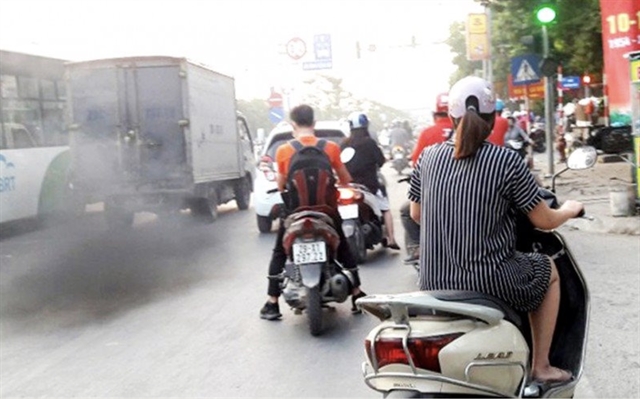 Society
Society

 |
| Hà Nội suffers severe air pollution in October. Photo moitruong.net.vn |
HÀ NỘI – The air pollution season could last until the end of March next year, according to meteorological experts.
Recently, air pollution in Hà Nội has persisted without any signs of improvement.
Earlier this month, residents witnessed dense and thick air, a common phenomenon in the capital city.
Air monitoring systems indicate that the air quality is very poor, posing a risk to the health of the elderly, young children and those with respiratory illnesses.
For several consecutive days, many locations in Hà Nội reached the purple level of air pollution — a hazardous level for health with an Air Quality Index (AQI) ranging from 153 to 222.
Despite recent rainfall across the city, the air quality is expected to remain poor.
According to meteorological experts, air pollution in northern Việt Nam, particularly in Hà Nội, is likely to continue for some time.
According to the director of the National Centre for Hydrometeorological Forecasting, alongside humid air from the Gulf of Bắc Bộ (Tonkin) brought in by southeast winds, morning haze is also caused by fine dust.
The temperature inversion conditions prevented pollutants from dispersing, causing them to accumulate near the ground, resulting in mist, fog and air pollution.
A lack of wind also led to minimal air mixing, concentrating pollutants at ground level.
Authorities identified unfavourable weather conditions as a major factor in exacerbating the pollution. The conditions limited the dispersion of pollutants, especially PM10 and fine PM2.5 particles.
For many years, the open burning of waste, straw and agricultural byproducts in fields has been widespread and frequent without effective measures to prevent it, contributing to air pollution and haze in urban and populated areas.
The Environmental Pollution Control Department has requested that local environmental and natural resources departments increase the frequency of air quality monitoring and publish monitoring results on electronic information portals and media channels for provinces and cities.
Localities are advising residents to immediately adopt health protection measures, particularly for those engaging in outdoor activities between 5-7am and 2-7pm.
At the same time, local authorities are required to inspect and supervise sources of emissions, especially open burning sites, waste burning, burning sites for straw and agricultural byproducts, construction sites and industrial production facilities.
Industrial production facilities are required to ensure that emissions meet environmental technical standards, especially those with large sources of dust and emissions.
Authorities should also enforce the monitoring and supervision of production facilities required to install automatic emissions monitoring systems that transmit data to the Department of Natural Resources and Environment.
Experts estimate that up to 70 per cent of urban environmental pollution emissions originate from vehicles.
In addition to emissions from vehicles, dust, sand and rocks also accumulate on roads due to transportation of construction materials, waste transport or poor-quality soil.
Noise pollution from vehicles and other sources is also common in urban areas, and can result in significant harm to the entire body, especially the auditory system.
Dr Hoàng Dương Tùng, chairman of the Việt Nam Clean Air Network, noted that based on observations over many years, air quality in Hà Nội tends to worsen during the winter.
During this season, emissions and fine dust are less likely to disperse and tend to accumulate in low-lying areas.
Meanwhile, sources of pollution from traffic and construction continue to emit pollutants. This means that the air pollution may persist until early next year, he said.
The air pollution season usually occurs from October until the end of March the following year. During periods without rain and calm winds, fine dust (PM2.5) can spread widely, according to the expert.
To improve air quality, in addition to controlling emissions sources, it is necessary to strictly address activities like waste burning and straw burning as stipulated in the Environmental Protection Law 2020, Tùng said.
Localities also need to educate residents on how to handle post-harvest byproducts, household waste and waste from craft villages, which must be taken to designated treatment facilities.
There should also be an emphasis on cleaning and road washing, especially in areas with multiple construction sites.
Poor air quality makes breathing difficult, increases coughing and can cause chest tightness, along with other respiratory symptoms. People with respiratory conditions should avoid going outside unless absolutely necessary when air pollution levels are high.
For asthma patients and those with chronic obstructive pulmonary disease (COPD), it is important to follow daily medication regimens as prescribed by doctors. If symptoms such as discomfort or shortness of breath arise, the dose of bronchodilators can be increased according to medical guidance. VNS




